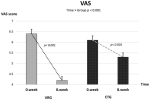Effect of Motion-Controlled Video Games-Based Virtual Reality Exercise on Patients with Post-COVID-19 Condition: A Randomized Controlled Trial
OBJECTIVE
Virtual reality (VR) exercises may offer a comprehensive rehabilitation approach for many conditions. This study primarily aimed to evaluate the effectiveness of VR exercises compared with conventional exercise in reducing pain intensity in individuals with post-COVID-19 condition (PCC). Secondary analyses explored their effects on fatigue, functional capacity, mood, and quality of life.
MATERIALS AND METHODS
A single-center, randomized, assessor-blinded intervention study was conducted with 79 individuals between July 2021 and February 2022. The primary outcome was pain intensity measured using the Visual Analog Scale (VAS). Secondary outcomes included mood (Hospital Anxiety and Depression Scale, HADS), fatigue (Fatigue Severity Scale, FSS), quality of life (SF-12), and functional exercise capacity (6-Minute Walk Test, 6 MWT). Participants completed supervised exercise sessions 3 times weekly for 30–45 min over 8 weeks. The conventional exercise program involved moderate-intensity aerobic, strength, stretching, and neuromuscular exercises. VR exercises were delivered semi-immersively using motion-controlled video games. Time × group interactions were analyzed using linear mixed-effects model.
RESULTS
In both groups, 6MWT, SF-12 physical and mental components increased, while VAS, FSS and HADS anxiety and depression scores decreased. Time-group interaction was observed in favor of VRG for VAS [F(1, 59.4) = 56.3, p = 0.001], as well as HADS-D [F(1, 54.6) = 7.40, p = 0.008] and FSS [F(1, 61.4) = 8.96, p = 0.004].
CONCLUSIONS
While structured exercise improves the physical and psychological conditions of individuals with PCC, virtual reality exercises stand out in pain, also fatigue, and depression.
Web | DOI | PDF | Healthcare | Open Access
Polat, Musa; Oba, Pınar; Karadağ, Ahmet
OBJECTIVE
Virtual reality (VR) exercises may offer a comprehensive rehabilitation approach for many conditions. This study primarily aimed to evaluate the effectiveness of VR exercises compared with conventional exercise in reducing pain intensity in individuals with post-COVID-19 condition (PCC). Secondary analyses explored their effects on fatigue, functional capacity, mood, and quality of life.
MATERIALS AND METHODS
A single-center, randomized, assessor-blinded intervention study was conducted with 79 individuals between July 2021 and February 2022. The primary outcome was pain intensity measured using the Visual Analog Scale (VAS). Secondary outcomes included mood (Hospital Anxiety and Depression Scale, HADS), fatigue (Fatigue Severity Scale, FSS), quality of life (SF-12), and functional exercise capacity (6-Minute Walk Test, 6 MWT). Participants completed supervised exercise sessions 3 times weekly for 30–45 min over 8 weeks. The conventional exercise program involved moderate-intensity aerobic, strength, stretching, and neuromuscular exercises. VR exercises were delivered semi-immersively using motion-controlled video games. Time × group interactions were analyzed using linear mixed-effects model.
RESULTS
In both groups, 6MWT, SF-12 physical and mental components increased, while VAS, FSS and HADS anxiety and depression scores decreased. Time-group interaction was observed in favor of VRG for VAS [F(1, 59.4) = 56.3, p = 0.001], as well as HADS-D [F(1, 54.6) = 7.40, p = 0.008] and FSS [F(1, 61.4) = 8.96, p = 0.004].
CONCLUSIONS
While structured exercise improves the physical and psychological conditions of individuals with PCC, virtual reality exercises stand out in pain, also fatigue, and depression.
Web | DOI | PDF | Healthcare | Open Access

